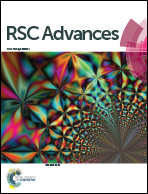A facile way to prepare nanoporous PbI2 films and their application in fast conversion to CH3NH3PbI3†
Abstract
In this report, we demonstrate a facile way to prepare PbI2 films with interpenetrating nanopores. The nanoporous PbI2 (n-PbI2) films were prepared by the solvent–solvent extraction (SSE) method, in which the DMF solvent was effectively extracted by isopropanol (IPA) within seconds, resulting in well-crystallized n-PbI2 films without annealing. The mechanism involved in the preparation of n-PbI2 films using the SSE method was studied further, and some universal rules for fabricating n-PbI2 films with the SSE method were proposed. The interpenetrating nanoporous morphology enabled fast penetration of the CH3NH3I (MAI) solution, so most of the PbI2 converted into CH3NH3PbI3 within 10 s even with a perovskite overlayer of 300 nm. Moreover, the perovskite layer was pinhole-free and smoother than that based on a conventional PbI2 film. Consequently, perovskite solar cells based on n-PbI2, with the setup as FTO/compact TiO2/bilayer CH3NH3PbI3/P3HT/Ag, delivered an impressive power conversion efficiency of 10.1%, compared with 5.9% for its counterpart based on a conventional compact PbI2 film. This work unveils the PbI2-morphology-related reaction kinetics in the two-step method, and will contribute to understanding the role PbI2 films play in the preparation of perovskites.


 Please wait while we load your content...
Please wait while we load your content...